Amanita augusta: the Blushing Yellow Veil Amanita
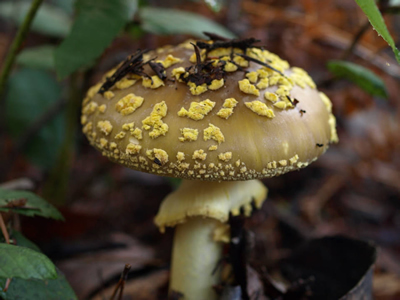
Amanita augusta
The lovely and gracile Yellow Veil Amanita is a commonly encountered member of our Northern and Central California mycota. I have found it as far south as Point Lobos in coastal California and as far north as Cordova, Alaska. It occurs throughout the Pacific Northwest and has been reported from Idaho and Montana. Amanita augusta, like most amanita species, is mycorrhizal. It forms symbiotic relationships with a variety of tree hosts, both conifers and hardwoods, and often occurs in mixed woodlands, where the mycorrhizal host is anyone’s guess. It can occur at any time during our mushroom season.
Amanita augusta (formerly A. franchetii and A. aspera) has a wide range of cap colors, from brilliant yellow to darkest brown and various combinations of the two. The center of the cap is sometimes umbonate. Its universal veil (UV) is yellow and friable, covering the entire button when young. As the mushroom expands, the veil breaks up into yellow warts on the cap. These warts can change in color to tan or gray with sun and rain exposure. Bits of bright yellow UV remnants can usually be found along the expanded, slightly rooting or bulbous stipe base or remaining in the ground when the mushroom is dug up. Its gills are white to cream colored and free or slightly attached to the upper stipe.
Amanita augusta is a member of Amanita section Validae, which contains the blushing amanitas. In fact, like both the Eastern and Western Blushers, A. “ameri-rubescens” nom. prov. and A. novinupta, A. augusta also blushes, although the reddening can be subtle and is often restricted to the stipe base or cracks in the base. Like all members of the Validae, it also has a membranous partial veil, which is pendulous and often rimmed in bright yellow. Amanitas in Subgenus Lepidella, which includes the Amidella, Validae, Lepidella and Phalloideae, have white spores that turn blue in Melzer’s (an iodine based) solution. The bluing is referred to as an amyloid reaction.

Note reddening base |
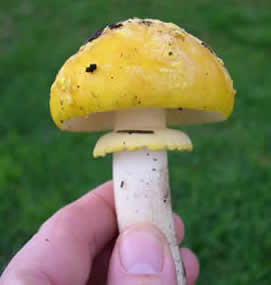
Bright yellow cap |
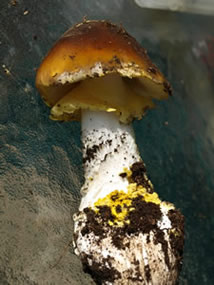
Yellow universal veil on stem |
Some members of Amanita section Validae are considered to be edible, although some are known to have hemolytic toxins that destroy red blood cells. Those heat sensitive toxins can usually be broken down into harmless components by thorough cooking, although there have been some reports of adverse effects even with long cooking. It is unknown whether A. augusta also has these toxins, but it is safest to assume this to be true.
A recent publication from British Columbia, “The Outer Spores: Mushrooms of Haida Gwaii” (2012) claimed that there have been ten deaths attributed to the consumption of Amanita “franchetii” in China, and that therefore A. augusta should be treated as a dangerously poisonous mushroom. I tracked down the original report from China, and could find no merit to these conclusions. At the very least, the mushrooms were misidentified. The photo shown was certainly not that of franchetii. Neither A. augusta nor franchetii even occur in China, and the symptoms shown by the poisoning victims matched no known amanita toxin.
For more comments on this curious poisoning and online amanita misinformation in general, you can read my January 2013 post to the BAMS discussion group.
A number of blushing amanitas are eaten around the world, including Amanita rubescens, a common market species in Europe, and Amanita “ameri-rubescens” nom. prov. in eastern North America, Amanita novinupta here in the west (although its flavor can vary from very good to nasty metallic), A. flavoconia and A. flavorubens, both market species in Mexico, and also eaten by some on the east coast of the USA, and Amanita perphaea, a choice and cherished edible species of the Patamona Indians of Guyana. Dr. Terry Henkel, a Professor at Humboldt State University, first documented the local use of this species. Although the women of the Patamona tribe are the usual gatherers of wild mushrooms, Amanita perphaea or “Pulutukwe” is gathered by the men, and given, wrapped in leaves, as a special gift to their wives.
David Arora has been experimenting with the edibility of Amanita augusta for several years, first trying it himself, then feeding it to his friends, then feeding it to his various classes and workshops. He recommends thorough cooking, just in case it contains hemolytic toxins. His experiments with this species as an edible are hardly controlled, however, so you are on your own insofar as safety. Reports that I have heard from folks who have attended David’s forays where he serves up amanitas say it is not delicious (“like cardboard,” was one quote), so it is probably not worth the bother, unless you are a bold McIlvainean who wants a long list of mushrooms that you have gagged down and survived!
I don’t recommend it.
But like I always say, you don’t have to eat amanitas to enjoy them!
Our handsome and readily recognizable Western Yellow Veil Amanita has gone under a number of latin names. It was well known among amanitologists that our Amanita augusta, a name recently published by Bojantchev, was not the same as the European species Amanita aspera or A. franchetii. Bojantchev formalized our knowledge with his naming, but sadly neglected to describe one of its many color morphs, a pure, bright yellow.
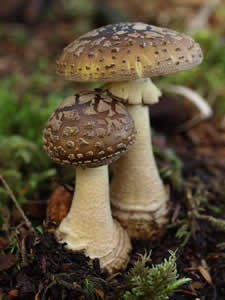
Alaskan A. augusta |
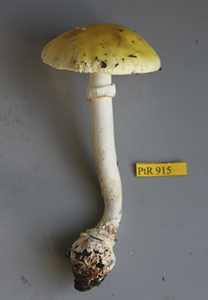
Point Reyes specimen, DNA determined |
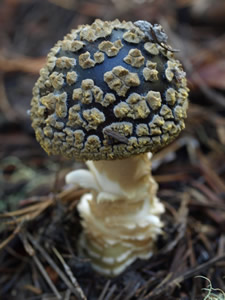
Dark brown A. augusta |
Bojantchev was merely following the mis-lead of many others, from Mykoweb to Thiers to both of our most recent western field guide publications: “Mushrooms of Western North America” (2012) and “California Mushrooms” (new publication date June 2015). For the record, David Arora did get it right, listing “bright yellow” as an “aspera” color morph in “Mushrooms Demystified” (1986) and “All That the Rain Promises and more ... “ (1991). I have collected bright yellow Yellow Veiled Amanitas for years, and never doubted that it was merely a color phase of franchetii/augusta, since all other features were identical. Recent DNA work at UC Berkeley by Dr. Tom Bruns, on material collected at the 10th Annual Point Reyes Fungus Fair, showed a 100% match of the yellow form with more classically colored individuals.
Please make a note of it.
© Debbie Viess, January 2015

 back to top
back to top